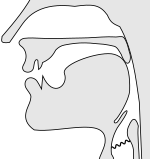| Voiced uvular plosive | |||
|---|---|---|---|
| ɢ | |||
| IPA Number | 112 | ||
| Audio sample | |||
| Encoding | |||
| Entity (decimal) | ɢ | ||
| Unicode (hex) | U+0262 | ||
| X-SAMPA | G\ | ||
| Braille | |||
| |||
The voiced uvular plosive or stop is a type of consonantal sound, used in some spoken languages. The symbol in the International Phonetic Alphabet that represents this sound is ⟨ɢ⟩, a small capital version of the Latin letter g, and the equivalent X-SAMPA symbol is G\.
[ɢ] is a rare sound, even compared to other uvulars.[1] Vaux proposes a phonological explanation: uvular consonants normally involve a neutral or a retracted tongue root, whereas voiced stops often involve an advanced tongue root: two articulations that cannot physically co-occur. This leads many languages of the world to have a voiced uvular fricative [ʁ] instead as the voiced counterpart of the voiceless uvular plosive. Examples are Inuit; several Turkic languages such as Uyghur and Yakut; several Northwest Caucasian languages such as Abkhaz; several Mongolic languages such as Mongolian and Kalmyk, as well as several Northeast Caucasian languages such as Ingush.
There is also the voiced pre-uvular plosive[2] in some languages, which is articulated slightly more front compared with the place of articulation of the prototypical uvular plosive, though not as front as the prototypical velar plosive. The International Phonetic Alphabet does not have a separate symbol for that sound, though it can be transcribed as ⟨ɢ̟⟩ (advanced ⟨ɢ⟩), ⟨ɡ̠⟩ or ⟨ɡ˗⟩ (both symbols denote a retracted ⟨ɡ⟩). The equivalent X-SAMPA symbols are G\_+ and g_-, respectively.

